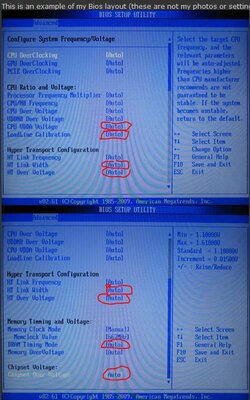- Joined
- May 28, 2011
Hello there,
I'm quite new to all this but last week I managed to unlock my 4th core and L3 Cache. I ran Prime95 and after about 45mins I got an error. I was told it could be one of my RAM sticks. I took out the offending RAM and ran Prime95 again and passed (20hours).
I have been putting off overclocking my CPU until my new CPU cooler (Zalman Performa) arrived and since it arrived yesterday I am now looking to OC my CPU. The only thing I have tried has been to see how much I can increase the FSB (not touching anything else) before my PC won't load (the answer being 240, up from 200)
I was hoping I could get some info on how to go about this, I've done plenty of reading and have got hold of some of the programs needed (eg. CPU-Z. HWMonitor, P95) but much of it, like how to setup voltages and the implications of FSB on RAM etc., goes over my head.
Here are my specs:
OS: Windows 7 64bit
Motherboard: ASUS M4A785TD-V EVO
CPU: AMD Athlon II X3 425 (unlocked to Phenom II X4 B25)
CPU Cooler: Zalman CNPS10X Performa
GPU: Sapphire Radeon HD6870 Vapor-X
RAM: 8 GB (2x4gb) Patriot 1333EL Series DDR3 PC3-10700
PSU: 750W CIT ATX
And here are some CPU-Z shots:



I'd really appreciate some help if possible.
Thanks
I'm quite new to all this but last week I managed to unlock my 4th core and L3 Cache. I ran Prime95 and after about 45mins I got an error. I was told it could be one of my RAM sticks. I took out the offending RAM and ran Prime95 again and passed (20hours).
I have been putting off overclocking my CPU until my new CPU cooler (Zalman Performa) arrived and since it arrived yesterday I am now looking to OC my CPU. The only thing I have tried has been to see how much I can increase the FSB (not touching anything else) before my PC won't load (the answer being 240, up from 200)
I was hoping I could get some info on how to go about this, I've done plenty of reading and have got hold of some of the programs needed (eg. CPU-Z. HWMonitor, P95) but much of it, like how to setup voltages and the implications of FSB on RAM etc., goes over my head.
Here are my specs:
OS: Windows 7 64bit
Motherboard: ASUS M4A785TD-V EVO
CPU: AMD Athlon II X3 425 (unlocked to Phenom II X4 B25)
CPU Cooler: Zalman CNPS10X Performa
GPU: Sapphire Radeon HD6870 Vapor-X
RAM: 8 GB (2x4gb) Patriot 1333EL Series DDR3 PC3-10700
PSU: 750W CIT ATX
And here are some CPU-Z shots:



I'd really appreciate some help if possible.
Thanks
Last edited:



